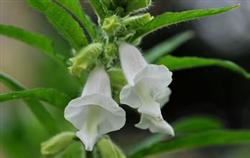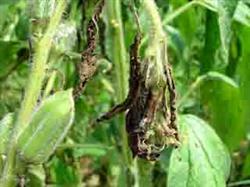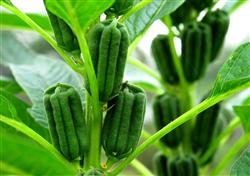Skillful use of growth regulators to promote recovery of sesame

Due to the high groundwater level in some sesame producing areas, the recent heavy rainfall caused too much water in the sesame field, resulting in wilting of sesame plants, stagnation of growth and development, falling of flowers and capsules, and even death of some plants, which affected the production of sesame in our province. In view of the current disaster situation of sesame in our province, the following measures can be taken: seize the opportunity to eliminate stagnant water in the field as soon as possible, dig drainage ditches according to the topography of the field for artesian drainage, and cast "waterproof walls" around low-lying places. Use a pump for mechanical drainage to ensure that the indicated water and stagnant water in the plough layer are discharged from the field within 24 hours. Ploughing and loosening soil moisture according to weather conditions, ploughing and loosening soil should be carried out in time to reduce soil moisture and increase roots. Ploughing should not be too deep, so as not to hurt too many roots and affect the growth of sesame seeds. In addition, combined with mid-tillage to cultivate soil, do a good job of burying roots and preventing toppling, so that there is sufficient water and fertilizer, which is conducive to the restoration of root growth. Topdressing the land damaged by waterlogging in time will lead to serious loss of soil nutrients, so it is necessary to topdressing and replenishing nutrients in time, generally applying 7kg urea per mu. The main types of topdressing are nitrogen and potash fertilizer, combined with a certain amount of phosphate fertilizer, and the best topdressing method is hole application or furrow application. Foliar fertilizer can be sprayed with root topdressing. After removing stagnant water in the field, 1% 2% urea solution and 0.2% potassium dihydrogen phosphate solution or 5% plant ash solution are sprayed 30 kg per mu. At the same time, 40% carbendazim suspension 700 times and 40% omethoate 1000 times 1500 times were sprayed to prevent sesame diseases and insect pests after the disaster, and sprayed again every 5-7 days. The utilization experiment of growth regulators showed that growth regulators could effectively alleviate the waterlogging injury of sesame. Ethephon: ethephon not only promotes ripening, but also promotes the growth of seedlings. In the aspect of waterlogging resistance, ethephon is needed to participate in adventitious root proliferation and root cortex aerenchyma formation under flooded conditions. Cytokinin: the experiment of Provincial Academy of Agricultural Sciences showed that the photosynthetic rate of sesame increased slightly after the application of cytokinin, which could reduce the waterlogging loss of sesame, and dwarf had a similar effect. Therefore, after the occurrence of waterlogging in the middle and later stage of sesame growth, spraying 50 × 10 ~ 6 to 200 × 10 ~ 6 cytokinins and other growth-promoting regulators can alleviate the waterlogging and increase the yield. In the area where sesame is prone to waterlogging, in order to resist waterlogging, 100 × 10 ~ (- 6) to 200 × 10 ~ (- 6) ethephon, active rooting agent and Yemanbao can be sprayed in sesame seedling stage to improve the structure of sesame root. improve the resistance and repair ability of sesame in adversity such as disease and waterlogging.
- Prev

Control methods of sesame bacterial wilt
First, the symptoms showed that sesame bacterial wilt occurred early, the root turned brown at the initial stage, the top of the plant drooped, and then dark green patches appeared on the stem, and gradually deepened and blackened. The leaves gradually drooped from top to bottom, the diseased plants were shorter than the healthy ones, the vascular bundles of the rhizomes turned brown, and finally the pith turned into holes. There are bacteria both inside and outside the stem.
- Next

Chasing "three fertilizers" for high yield of sesame
Double-stem cultivation is that the tip of the main stem is removed at the seedling stage of sesame, and the axillary buds at the base of the stem are used to promote the growth of two stalks similar to the original main stem, which can greatly increase the number of pods and increase the yield. Generally increase the income of sesame seeds by about 10 kilograms per mu. Therefore, double-stem cultivation is a new method for high yield of sesame.
Related
- The first cup of black tea in spring, the flavor and history of tea gardens in Kenya, Africa
- The computer can not only choose potatoes, but also grow tea rice. AI will grow winter oolong tea champion.
- It is not only the inflated tea bitten by insects, but also engraved with the four seasons tea in Beipu.
- The Oriental Beauty Tea Festival in Zhuxian County takes the stage at the weekend to experience the plus-size feast of oil tea.
- & quot; Oriental Beauty Tea & Exploration of Emei in Hsinchu, the hometown of quot;
- The new variety of strawberry "Tainong 1" dessert is the first choice with mellow aroma. Crimson gorgeous
- History of Tea in Taiwan: from Wild Inner Mountain to Export Tea Garden
- Two types of Taiwan Oriental Beauty Black Tea won the British three-Star Award for Childhood Tea Xiang Zhang Jiaqi changed from pilot to champion tea maker.
- Banana species and varieties: the planting history of Taiwan Xianren banana and dwarf banana is long, is banana disease resistant?
- Coffee planting Technology: Qianjie Coffee from Seedling to harvesting

